Ruthenians
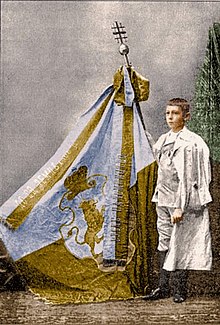 A boy with the pilgrimage blue-yellow flag during the Ruthenian pilgrimage to the Holy Land in 1906. | |
| Languages | |
|---|---|
| Previously Ruthenian; currently Belarusian, Ukrainian and Rusyn lect | |
| Religion | |
| Predominantly Eastern Orthodox Eastern Greek Catholic, Roman Catholic, Protestant (minorities) | |
| Related ethnic groups | |
| Other East Slavs |
Ruthenians and Ruthenes (Latin: Rutheni) are exonyms of Latin origin, formerly used in Western and Central Europe as common designations for East Slavs, particularly during the late medieval and early modern periods. Latin term Rutheni was initially used, since the 11th century, as an exonymic designation for people of the medieval Kievan Rus', thus including ancestors of the modern Ukrainians, Rusyns and the most of Belarusians.[1] The use of Ruthenian designations was continued throughout the early modern period, acquiring several distinctive meanings, both in terms of their regional scopes and additional religious connotations (see: Ruthenian Rite).[2][3][4][5][6]
In medieval and early modern sources, Latin term Rutheni was commonly applied to East Slavs in general, thus encompassing all endonymic (native) self-designations and their various forms (Ukrainian: русини, Belarusian: русіны, Russian: русины). By opting for the use of exonymic terms, authors who wrote in Latin were relieved from the need to be specific in their applications of those terms, and the same quality of Ruthenian designations is often recognized by modern, mainly Western authors, particularly those who prefer to use exonymic (foreign in origin) over endonymic (native in origin) designations.[7][8][9]
During the early modern period, Ruthenian designations were used most frequently as common exonyms for the entire East Slavic population within the borders of the Polish–Lithuanian Commonwealth, that was encompassing territories of modern Ukraine and Belarus from the 15th up to the 18th centuries.[10][11] In the former Austro-Hungarian Monarchy, the same term (German: Ruthenen) was employed (up to 1918) as an official exonymic designation for the entire East Slavic population within the borders of the Monarchy.[12]
History[]

Ruteni, a misnomer that was also the name of an extinct and unrelated Celtic tribe in Ancient Gaul,[7] was used in reference to Rus' in the Annales Augustani of 1089.[7] An alternative early modern Latinisation, Rucenus (plural Ruceni) was, according to Boris Unbegaun, derived from Rusyn.[7] Baron Herberstein, describing the land of Russia, inhabited by the Rutheni who call themselves Russi, claimed that the first of the governors who rule Russia is the Grand Duke of Moscow, the second is the Grand Duke of Lithuania and the third is the King of Poland.[13][14]
According to professor of Ukrainian origin John-Paul Himka from the University of Alberta the word Rutheni did not include the modern Russians, who were known as Moscovitae.[7] Vasili III of Russia, who ruled the Grand Duchy of Moscow in the 16th century, was known in European Latin sources as Rhuteni Imperator.[15] Jacques Margeret in his book "Estat de l'empire de Russie, et grande duché de Moscovie" of 1607 explained, that the name "Muscovites" for the population of Tsardom (Empire) of Russia is an error.[citation needed] During conversations, they called themselves rusaki (which is a colloquial term for Russians) and only the citizens of the capital called themself "Muscovites". Margeret considered that this error is worse than calling all the French "Parisians."[16][17] Professor David Frick from the Harvard Ukrainian Research Institute has also found in Vilnius the documents from 1655, which demonstrate that Moscovitae were also known in Lithuania as Rutheni.[18] The 16th century Portuguese poet Luís Vaz de Camões in his Os Lusíadas" (Canto III, 11)[19][20] clearly writes "...Entre este mar e o Tánais vive estranha Gente: Rutenos, Moscos e Livónios, Sármatas outro tempo..." differentiating between Ruthenians and Muscovites.

1, 2. Galician Ruthenians;
3. Carpathian Ruthenians;
4, 5. Podolian Ruthenians.

After the partition of Poland the term Ruthenian referred exclusively to people of the Rusyn- and Ukrainian-speaking areas of the Austro-Hungarian Empire, especially in the Kingdom of Galicia and Lodomeria, Bukovina, and Transcarpathia.[7]
At the request of Mykhajlo Levitsky, in 1843 the term Ruthenian became the official name for the Rusyns and Ukrainians within the Austrian Empire.[7] For example, Ivan Franko and Stepan Bandera in their passports were identified as Ruthenians (Polish: Rusini).[21] By 1900 more and more Ruthenians began to call themselves with the self-designated name Ukrainians.[7] A number of Ukrainian members of the intelligentsia, such as Mykhailo Drahomanov and Ivan Franko, perceived the term as narrow-minded, provincial and Habsburg.[citation needed] With the emergence of Ukrainian nationalism during the mid-19th century, use of "Ruthenian" and cognate terms declined among Ukrainians and fell out of use in Eastern and Central Ukraine. Most people in the western region of Ukraine followed suit later in the 19th century. During the early 20th century, the name Ukrajins’ka mova ("Ukrainian language") became accepted by much of the Ukrainian-speaking literary class in the Austro-Hungarian Kingdom of Galicia and Lodomeria.[citation needed]
Following the dissolution of the Austro-Hungarian Empire in 1918, new states emerged and dissolved; borders changed frequently. After several years the Rusyn and Ukrainian speaking areas of eastern Austria-Hungary found themselves divided between the Ukrainian Soviet Republic, Czechoslovakia, Poland, and Romania.
When commenting on the partition of Czechoslovakia by Nazi Germany in March 1939, US diplomat George Kennan noted, "To those who inquire whether these peasants are Russians or Ukrainians, there is only one answer. They are Neither. They are simply Ruthenians."[22] Dr. Paul R. Magocsi emphasizes that modern Ruthenians have "the sense of a nationality distinct from Ukrainians" and often associate Ukrainians with Soviets or Communists.[23]
After the expansion of Soviet Ukraine following World War II, several groups who had not previously considered themselves Ukrainians were merged into the Ukrainian identity.[24]
Ruthenian terminology in Poland[]
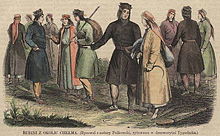

In the Interbellum period of the 20th century, the term rusyn (Ruthenian) was also applied to people from the Kresy Wschodnie (the eastern borderlands) in the Second Polish Republic, and included Ukrainians, Rusins, and Lemkos, or alternatively, members of the Uniate or Greek Catholic Church churches. In Galicia, the Polish government actively replaced all references to "Ukrainians" with the old word rusini ("Ruthenians"), an action that caused many Ukrainians to view their original self-designation with distaste.[25]
The Polish census of 1921 considered Ukrainians no other than Ruthenians.[26] However the Polish census of 1931 counted Belarusian, Ukrainian, Russian, and Ruthenian as separate language categories, and the census results were substantially different from before.[27] According to Rusyn-American historian Paul Robert Magocsi, Polish government policy in the 1930s pursued a strategy of tribalization, regarding various ethnographic groups—i.e., Lemkos, Boikos, and Hutsuls, as well Old Ruthenians and Russophiles—as different from other Ukrainians (although no such category existed in the Polish census apart from the first-language speakers of Russian[27]), and offered instructions in Lemko vernacular in state schools set up in the westernmost Lemko Region.[28]
The Polish census of 1931 listed "Russian", "Ruthenian" and "Ukrainian" (Polish: rossyjski, ruski, ukraiński, respectively) as separate languages.[29][30]
Carpatho-Ruthenian designations[]
By the end of the 19th century, another set of terms came into use in several western languages, combining regional Carpathian with Ruthenian designations, and thus producing composite terms such as: Carpatho-Ruthenes or Carpatho-Ruthenians. Those terms also acquired several meanings, depending on the shifting geographical scopes of the term Carpathian Ruthenia. Those meanings were also spanning from wider uses as designations for all East Slavs of the Carpathian region, to more narrower uses, focusing on those local groups of East Slavs who did not accept modern Russian or Ukrainian identities, but rather opted to keep their traditional Rusyn identity.[31]
The designations Rusyn and Carpatho-Rusyn were banned in the Soviet Union by the end of World War II in June 1945.[32] Ruthenians who identified under the Rusyn ethnonym and considered themselves to be a national and linguistic group separate from Ukrainians and Belarusians were relegated to the Carpathian diaspora and formally functioned among the large immigrant communities in the United States.[23][32] A cross-European revival took place only with the collapse of communist rule in 1989.[32] This has resulted in political conflict and accusations of intrigue against Rusyn activists, including criminal charges. The Rusyn minority is well represented in Slovakia. The single category of people who listed their ethnicity as Rusyn was created in the 1920s, however, no generally accepted standardised Rusyn language existed.[33]
After World War II, following the practice in the Soviet Union, Ruthenian ethnicity was disallowed. This Soviet policy maintained that the Ruthenians and their language were part of the Ukrainian ethnic group and language. At the same time, the Greek Catholic church was banned and replaced with the Eastern Orthodox church under the Russian Patriarch, in an atmosphere which repressed all religions. Thus, in Slovakia, the former Ruthenians were technically free to register as any ethnicity but Ruthenian.[33]
The government of Slovakia has proclaimed Rusyns (Rusíni) to be a distinct national minority (1991) and recognised Rusyn language as a distinct language (1995).[7]
Speculative theories[]

Since the 19th century, several speculative theories emerged regarding the origin and nature of medieval and early modern uses of Ruthenian terms as designations for East Slavs. Some of those theories were focused on a very specific source, a memorial plate from 1521, that was placed in the catacombe Chapel of St Maximus in Petersfriedhof, the burial site of St Peter's Abbey in Salzburg (modern Austria). The plate contains Latin inscription that mentions Italian ruler Odoacer (476-493) as king of "Rhutenes" or "Rhutenians" (Latin: Rex Rhvtenorvm), and narrates a story about the martirdom of St Maximus during an invasion of several peoples into Noricum in 477. Due to the very late date (1521) and several anachronistic elements, the content of that plate is considered as legendary.[34][35]
In spite of that, some authors (mainly non-scholars) employed that plate as a "source" for several theories that were trying to connect Odoacer with ancient Celtic Ruthenes from Gaul, thus also providing an apparent bridge towards later medieval authors who labeled East Slavs as Ruthenes or Ruthenians. On those bases, an entire strain of speculative theories was created, regarding the alleged connection between ancient Gallic Ruthenes and later East Slavic "Ruthenians".[36] As noted by professor Paul R. Magocsi, those theories should be regarded as "inventive tales" of "creative" writers.[37][38]
Geography[]
From the 9th century, the main Rus' state, which was known later as Kievan Rus' – and is now part of the modern states of Ukraine, Belarus and Russia – was known in Western Europe by a variety of names derived from Rus'. From the 12th century, the land of Rus' was usually known in Western Europe by the Latinised name Ruthenia.[citation needed]

Kievan Rus', also known as Ruthenia, c. 1230
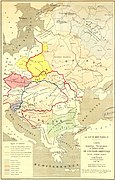 1868 linguistic, ethnographic, and political map of Eastern Europe by Casimir DelamarreRuthenians and Ruthenian language
1868 linguistic, ethnographic, and political map of Eastern Europe by Casimir DelamarreRuthenians and Ruthenian language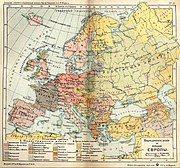
1907 linguistic and ethnographic map that indicates Ukrainians as "Little Russians or Ruthenians"

1911 map depicting the Austro-Hungarian Empire, with Ruthenians in light green
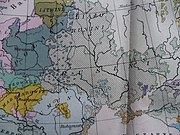
1927 Polish map that indicates Ukrainians as "Ruthenians" ("Rusini"), and Belarusians as "White Ruthenians" ("Bialo Rusini").

Caption says following: "In the ruled area Ukrainian (Ruthenian) speech predominates…"
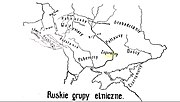
Ethnographic groups of Ruthenians, from "Rusini, zarys etnografii na Rusi" (1928)
See also[]
- American Carpatho-Ruthenian Orthodox Diocese
- Coat of arms of Carpathian Ruthenia
- Polish–Lithuanian–Ruthenian Commonwealth
- Ruthenian Greek Catholic Church
- Ruthenian nobility
- Ukrainian Greek Catholic Church
- Ukrainian Russophiles
References[]
- ^ Rusyn (Ruthenian), Encyclopedia Britannica, Paul Robert Magocsi
- ^ Shipman 1912a, p. 276-277.
- ^ Shipman 1912b, p. 277-279.
- ^ Krajcar 1963, p. 79-94.
- ^ Litauen und Ruthenien : Studien zu einer transkulturellen Kommunikationsregion (15.-18. Jahrhundert) = Lithuania and Ruthenia : studies of a transcultural communication zone (15th-18th centuries). Rohdewald, Stefan., Frick, David A., Wiederkehr, Stefan. Wiesbaden. 2007. p. 22. ISBN 9783447056052. OCLC 173071153.CS1 maint: others (link)
- ^ Encyclopedia Britannica: Paul Robert Magocsi, Rusyn-people
- ^ Jump up to: a b c d e f g h i Himka, John-Paul. "Ruthenians". www.encyclopediaofukraine.com. Internet Encyclopedia of Ukraine.
- ^ Himka 1999, p. 8-9.
- ^ Magocsi 2015, p. 2-5.
- ^ Bunčić 2015, p. 276-289.
- ^ Statute of the Grand Duchy of Lithuania (1529), Part. 1., Art. 1.: "На первей преречоным прелатом, княжатом, паном, хоруговым, шляхтам и местом преречоных земель Великого князства Литовского, Руского, Жомойтского и иных дали есмо:..."; According to.: Pervyi ili Staryi Litovskii Statut // Vremennik Obschestva istorii i drevnostei Rossiiskih. 1854. Book 18. p. 2-106. P. 2.
- ^ Moser 2018, p. 87-104.
- ^ Sigismund von Herberstein Rerum Moscoviticarum Commentarii
- ^ Myl'nikov 1999, p. 46.
- ^ Лобин А. Н. Послание государя Василия III Ивановича императору Карлу V от 26 июня 1522 г.: Опыт реконструкции текста // Studia Slavica et Balcanica Petropolitana, № 1. Санкт-Петербург, 2013. C. 131.
- ^ Dunning, Chester (15 June 1983). The Russian Empire and Grand Duchy of Muscovy: A Seventeenth-Century French Account. University of Pittsburgh Pre. pp. 7, 106. ISBN 978-0-8229-7701-8.
- ^ Myl'nikov 1999, p. 84.
- ^ Frick D. Ruthenians and their language in Seventeenth-century Vilnius, in: Speculum Slaviae Orientalis, IV. pp. 44-65.
- ^ Fabio Renato Villela. Os Lusíadas, Canto III, 11. Adaptação De Os LusÍadas Ao Português Atual.
- ^ Luís de Camões «Os Lusíadas. Canto Terceiro». www.tania-soleil.com.
- ^ (in Russian) Panayir, D. Muscophillia. How Galicians taught Russians to love Russia (Москвофільство. Як галичани вчили росіян любити Росію). Istorychna Pravda (Ukrayinska Pravda). 16 February 2011
- ^ Report on Conditions in Ruthenia March 1939, From Prague After Munich: Diplomatic Papers 1938-1940, (Princeton University Press, 1968)
- ^ Jump up to: a b Magocsi 1995, p. 221-231.
- ^ "Ruthenian: also called Rusyn, Carpatho-Rusyn, Lemko, or Rusnak". Status since the end of World War II. Encyclopædia Britannica.
Subcarpathian Rus was ceded by Czechoslovakia to the Soviet Union and became the Transcarpathian oblast (region) of the Ukrainian S.S.R. The designations Rusyn and Carpatho-Rusyn were banned, and the local East Slavic inhabitants and their language were declared to be Ukrainian. Soviet policy was followed in neighbouring communist Czechoslovakia and Poland, where the Carpatho-Rusyn inhabitants (Lemko Rusyns in the case of Poland) were henceforth officially designated Ukrainians
- ^ Magocsi 2010, p. 638: [...] the Polish government never referred to the Ukrainians and their language by the modern name Ukrainian; instead, it used the historical name Rusyn (Polish: Rusin), thereby inadvertently contributing to a disliking on the part of many Ukrainians, especially Galician Ukrainians, for their original national designation.
- ^ (Polish) Główny Urząd Statystyczny (corporate author) (1932) "Ludnosc, Ludnosc wedlug wyznania religijnego i narodowosci" (table 11, pg. 56
- ^ Jump up to: a b (Polish) Główny Urząd Statystyczny (corporate author) (1932) "Ludnosc. Ludnosc wedlug wyznania i plci oraz jezyka ojczystego" (table 10, pg. 15).
- ^ Magocsi 2010, p. 638-639.
- ^ Henryk Zieliński, Historia Polski 1914-1939, (1983) Wrocław: Ossolineum
- ^ "Główny Urząd Statystyczny Rzeczypospolitej Polskiej, drugi powszechny spis ludności z dn. 9.XII 1931 r. - Mieszkania i gospodarstwa domowe ludność" [Central Statistical Office the Polish Republic, the second census dated 9.XII 1931 - Abodes and household populace] (PDF) (in Polish). Central Statistical office of the Polish Republic. 1938. p. 15. Archived from the original (PDF) on 17 March 2014.
- ^ Magocsi 2015, p. 2-14.
- ^ Jump up to: a b c "Ruthenian: also called Rusyn, Carpatho-Rusyn, Lemko, or Rusnak". Status since the end of World War II. Encyclopædia Britannica.
Today the name Rusyn refers to the spoken language and variants of a literary language codified in the 20th century for Carpatho-Rusyns living in Ukraine (Transcarpathia), Poland, Slovakia, Hungary, and Serbia (the Vojvodina).
- ^ Jump up to: a b Christina Bratt Paulston, Donald Peckham (1998). Linguistic Minorities in Central and Eastern Europe. Soviet Heritage: Ruthenians. Multilingual Matters. pp. 258–259. ISBN 1853594164. Retrieved 8 October 2015.CS1 maint: uses authors parameter (link)
- ^ Friedhof und Katakomben im Stift St. Peter
- ^ Рыбалка 2020, p. 281-307.
- ^ Шелухин 1929, p. 20-27.
- ^ Magocsi 2010, p. 58-59.
- ^ Magocsi 2015, p. 50-51.
Sources[]
- Bunčić, Daniel (2015). "On the dialectal basis of the Ruthenian literary language" (PDF). Die Welt der Slaven. 60 (2): 276–289.
- Himka, John-Paul (1999). Religion and Nationality in Western Ukraine: The Greek Catholic Church and the Ruthenian National Movement in Galicia, 1870-1900. Montreal & Kingston: McGill-Queen's University Press. ISBN 9780773518124.
- Juchnowski, Jerzy; Sielezin, Jan R.; Maj, Ewa (2018). The Image of «White» and «Red» Russia in the Polish Political Thought of the 19th and 20th Century. Berlin: Peter Lang.
- Krajcar, Jan (1963). "A Report on the Ruthenians and their Errors, prepared for the Fifth Lateran Council". Orientalia Christiana Periodica. 29: 79–94.
- Litwin, Henryk (1987). "Catholicization among the Ruthenian Nobility and Assimilation Processes in the Ukraine during the Years 1569-1648" (PDF). Acta Poloniae Historica. 55: 57–83.
- Magocsi, Paul R. (1995). "The Rusyn Question". Political Thought: Ukrainian Journal of Political Science. 2–3: 221–231.
- Magocsi, Paul R.; Pop, Ivan I., eds. (2005) [2002]. Encyclopedia of Rusyn History and Culture (2. rev. ed.). Toronto: University of Toronto Press.
- Magocsi, Paul R. (2010) [1996]. A History of Ukraine: The Land and Its Peoples (2. rev. ed.). Toronto: University of Toronto Press. ISBN 9781442610217.
- Magocsi, Paul R. (2011). "The Fourth Rus': A New Reality in a New Europe" (PDF). Journal of Ukrainian Studies. 35-36 (2010-2011): 167–177.
- Magocsi, Paul R. (2015). With Their Backs to the Mountains: A History of Carpathian Rus' and Carpatho-Rusyns. Budapest-New York: Central European University Press. ISBN 9786155053467.
- Moser, Michael A. (2018). "The Fate of the Ruthenian or Little Russian (Ukrainian) Language in Austrian Galicia (1772-1867)". Harvard Ukrainian Studies. 35 (2017-2018) (1/4): 87–104. JSTOR 44983536.
- Myl'nikov, Alexander (1999). The Picture of the Slavic World: The View from the Eastern Europe: Views of Ethnic Names and Ethnicity (XVIth–beginning of the XVIIIth century). St. Petersburg: Петербургское востоковедение. ISBN 5-85803-117-X.
- Nakonechny, Ye. УКРАДЕНЕ ІМ’Я чому русини стали українцями [Stolen Name: Why Ruthenians Became Ukrainians] (in Ukrainian). Stefanyk Science Library (National Academy of Sciences of Ukraine). Lviv, 2001.
- Рыбалка, Андрей А. (2020). "Сны аббата Килиана". Novogardia: Международный журнал по истории и исторической географии Средневековой Руси. 5 (1): 281–307.
- Slivka, John (1973). Correct nomenclature: Greek rite or Byzantine rite: Rusin or Ruthenian: Rusin or Slovak?. Brooklyn, N.Y.
- Slivka, John (1989) [1977]. Who are we? Nationality: Rusin, Russian, Ruthenian, Slovak? Ecclesiastical name: Greek Rite Catholic, Byzantine Rite Catholic? (2. ed.). Brooklyn, N.Y.
- Shipman, Andrew J. (1912a). "Ruthenian Rite". The Catholic Encyclopedia. 13. New York: Robert Appleton Company. pp. 276–277.
- Shipman, Andrew J. (1912b). "Ruthenians". The Catholic Encyclopedia. 13. New York: Robert Appleton Company. pp. 277–279.
- Soloviev, Alexandre V. (1959). "Weiß-, Schwarz- und Rotreußen: Versuch einer historisch-politischen Analyse". Jahrbücher für Geschichte Osteuropas. 7 (1): 1–33.
- Шелухин, Сергій (1929). Звідкіля походить Русь: Теорія кельтського походження Київської Русі з Франції (PDF). Прага.
External links[]
| Wikimedia Commons has media related to Ruthenians. |
- Herbermann, Charles, ed. (1913). . Catholic Encyclopedia. New York: Robert Appleton Company.
- Himka, John-Paul. "Ruthenians". www.encyclopediaofukraine.com. Internet Encyclopedia of Ukraine.
- Carpatho-Rusyn Heritage - The Carpathian Connection
- Ruthenians
- Ruthenian people
- Exonyms
- Grand Duchy of Lithuania
- Ukrainian studies







